
Feudalism and popular sovereignty are two distinct political systems that have shaped the course of history and the development of societies in different ways. Understanding the differences between these two systems is crucial in understanding how power and authority have been organized throughout history.
Feudalism
Feudalism was a medieval European political and economic system in which land was divided into smaller parcels and held by vassals from lords in exchange for military service and other obligations. This system developed in the 9th and 10th centuries and reached its peak during the High Middle Ages. The key elements of feudalism include:
- Feudal hierarchy: In feudal societies, power and authority were organized in a hierarchical structure, with kings at the top, followed by lords, vassals, and peasants.
- Land ownership: Land was the basis of power and wealth in the feudal system. Lords owned vast estates, which they granted to vassals in exchange for loyalty and service.
- Feudal obligations: Vassals were obligated to provide military service, financial payments, and other forms of support to their lords in exchange for land and protection.
- Local governance: The feudal system was highly decentralized, with local lords holding significant political and judicial power within their territories.
Popular Sovereignty
Popular sovereignty, on the other hand, is a concept that emerged during the Enlightenment and has become a fundamental principle in modern democratic societies. It emphasizes the idea that political power resides in the hands of the people and that governments derive their authority from the consent of the governed. Key aspects of popular sovereignty include:
- Popular participation: In systems based on popular sovereignty, the people have the right to participate in the political process through voting, representative government, and other forms of civic engagement.
- Government legitimacy: The legitimacy of government is derived from the will of the people, and rulers are accountable to the citizenry for their actions and decisions.
- Rule of law: Popular sovereignty is closely associated with the rule of law, which ensures that government powers are limited and that individual rights and freedoms are protected.
- Democratic institutions: Popular sovereignty is typically associated with democratic institutions such as elections, separation of powers, and constitutional protections for individual rights.
Differences Between Feudalism and Popular Sovereignty
While feudalism and popular sovereignty are both systems for organizing political power, they differ in several key aspects:
- Origin and historical context: Feudalism originated in medieval Europe and was based on the personal relationships between lords and vassals, while popular sovereignty emerged during the Enlightenment as a response to absolute monarchy and authoritarian rule.
- Power relationships: In feudalism, power was distributed vertically, from the king down to the peasants, whereas in popular sovereignty, power is considered to be distributed horizontally among the people.
- Role of the people: In feudalism, the role of the common people was limited to serving the interests of their lord, while in popular sovereignty, the people are viewed as the ultimate source of political authority.
- Organizational structure: Feudal societies were characterized by a rigid hierarchical structure, while systems based on popular sovereignty tend to be more flexible and participatory.
- Legal framework: Feudalism was not based on a comprehensive legal framework but rather on personal relationships and customary law, while systems based on popular sovereignty are typically governed by written constitutions and legal codes.
Impact on Society and Governance
Feudalism and popular sovereignty have had vastly different impacts on the development of societies and the organization of political power:
- Feudalism: The feudal system contributed to the decentralization of power and the fragmentation of political authority, which led to a complex patchwork of local jurisdictions and conflicting allegiances.
- Popular sovereignty: Systems based on popular sovereignty have promoted the centralization of power, the expansion of civil rights, and the development of democratic institutions.
FAQs
What are some examples of feudal societies?
Feudal societies were prevalent in medieval Europe, but similar systems also existed in other parts of the world, including feudal Japan and parts of the Middle East.
How does popular sovereignty influence modern governance?
Popular sovereignty forms the basis of modern democratic governance, shaping the way political power is organized and asserting the primacy of the people in the political process.
Can a society have elements of both feudalism and popular sovereignty?
Yes, many societies have undergone transitions from feudal systems to more democratic forms of governance, resulting in a mix of feudal and democratic institutions and practices.
Overall, the differences between feudalism and popular sovereignty reflect the ongoing evolution of political systems and the changing nature of power and authority in human societies. Understanding these differences is crucial in understanding the historical and contemporary dynamics of governance and political organization.



